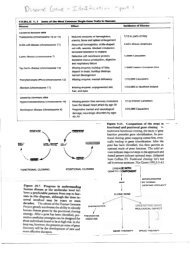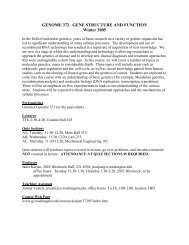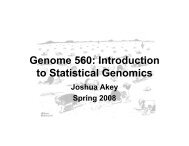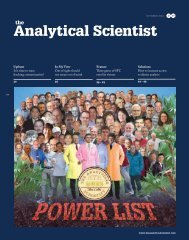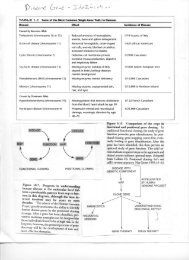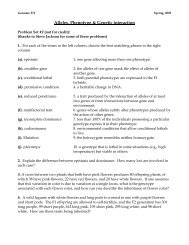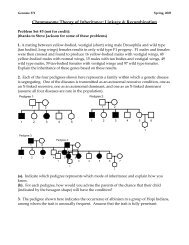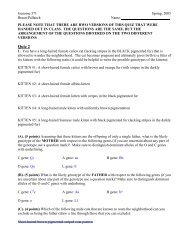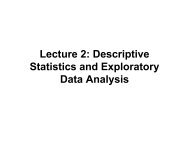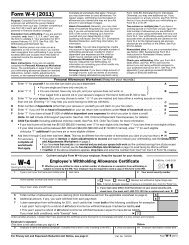You also want an ePaper? Increase the reach of your titles
YUMPU automatically turns print PDFs into web optimized ePapers that Google loves.
parents<br />
half-moon female progeny derived from the cross<br />
5kb<br />
2kb<br />
(d). Assuming the results shown above are representative of results obtained with the remaining halfmoon<br />
female offspring, what does this information suggest about the linkage relationship between the G<br />
and H genes? If they are linked, what map distance separates the genes?<br />
There appear to be six parental types and 4 recombinant types (circled) among the half-moon female<br />
progeny. Since the recombinant types are found less often than the parental types these results are<br />
consistent with linkage between the molecular marker and the Half-moon trait. Because the RFLP<br />
corresponds to the body color trait (G), these results indicate that G and half-moon (H) are linked. The<br />
map distance separating the G and H genes is calculated as follows:<br />
4/10(100) = 40cM<br />
(e). Draw the genetic map that is consistent with this data and that from the first part of this problem. Be<br />
sure to show the L, G, and H genes and M marker on the map and the linkage distances separating these<br />
genes/markers. Indicate the two possible locations for the half-moon gene (H) that are consistent with<br />
this data.<br />
H<br />
40cM<br />
G<br />
17cM<br />
M<br />
35cM<br />
L<br />
OR<br />
G<br />
17cM<br />
M<br />
35cM<br />
H<br />
L<br />
40cM<br />
Problem 4. (15 total points) You are studying aging in fruit flies and have generated six different<br />
homozygous long-lived fly mutants (you may assume that each of these mutant strains bears a mutation<br />
affecting only ONE gene). You now wish to determine how many genes these six mutants represent and<br />
proceed to set up pairwise crosses with all of the homozygous mutants. Results of this analysis are shown<br />
in the table below (where the intersection represents the phenotype of the offspring resulting from a<br />
particular cross):<br />
Mut 1 Mut 2 Mut 3 Mut 4 Mut 5 Mut 6 WT<br />
6



